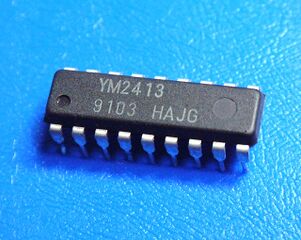Difference between revisions of "YM2413"
From Sega Retro
(→Design) |
(→Design) |
||
| (2 intermediate revisions by the same user not shown) | |||
| Line 1: | Line 1: | ||
| − | |||
{{ICBob | {{ICBob | ||
| image=YM2413.jpg | | image=YM2413.jpg | ||
| Line 6: | Line 5: | ||
| date= | | date= | ||
}} | }} | ||
| − | The '''YM2413''', also called '''OPLL''', is a cost-reduced audio chip manufactured by [[Yamaha]] | + | The Yamaha '''YM2413''', also called '''OPLL''', is a cost-reduced audio chip manufactured by [[Yamaha]], based on their earlier YM3812 (OPL2) chip. |
==Design== | ==Design== | ||
| − | + | The YM2413 uses FM synthesis based on the OPL (FM '''Op'''erator Type-'''L''') series, which is a low-cost version of other forms of FM synthesis used in other chips with 4 or more FM operators. It can generate up to 9 voices with 2 FM operators for each channel. The last three channels can be swapped out for rhythm channels, which can use any of the 5 percussion sounds using the three channels. | |
| − | The YM2413 was used on the MSX-Music sound expansion on the [[MSX]] | + | To make the chip cheaper to manufacture, many of the internal registers were removed. The result of this is that the YM2413 can only play one user-defined instrument at a time; the other 15 instrument settings are hard-coded and cannot be altered by the user. There were other cost-cutting modifications: the number of waveforms was reduced to two, and an adder is not used to mix the channels; instead, the chip's built-in DAC plays each channel one after the other, and the output of this is usually passed through an analog filter. This is similar to what would also be done with the [[YM2612]] later on. |
| + | |||
| + | ==Usage== | ||
| + | The YM2413 was notably used on the MSX-Music sound expansion on the [[MSX]] as well as on the [[FM Sound Unit]] for the [[Sega Mark III]] and the Japanese [[Sega Master System]]. It can also be found in some arcade boards by SNK and Alpha Denshi in the late 1980's, as well as in some Yamaha Portasound keyboards. The Famicom game ''Lagrange Point'' also contains the Konami-designed VRC7 mapper circuit that has an FM sound core based on the YM2413 with some differences. | ||
| + | |||
| + | ==Technical specifications== | ||
| + | :''See [[Sega Master System/Technical specifications|Sega Master System: Technical specifications]] for further information'' | ||
| + | |||
| + | * Clock rate: | ||
| + | :* [[Sega Master System]]: 3.579545 MHz | ||
| + | * Sound output: Mono | ||
| + | * Sound channels: 9 | ||
| + | :* Default configuration: 9 channels (9 FM channels) | ||
| + | :* Alternative configuration: 9 channels (6 FM channels, 3 rhythm channels) | ||
| + | * [[wikia:w:c:electronicmusic:Frequency modulation|FM synthesis]]: | ||
| + | :* FM channels: 6-9 channels (6 channels with rhythm mode, 9 channels without rhythm mode) | ||
| + | :* Instruments: 15 pre-defined instruments and one user-defined sound | ||
| + | :* Rhythm mode: 3 channels can be used for percussion sounds | ||
| + | ::* Percussion: 5 percussion sounds (bass drum, snare drum, tom-tom, top cymbal, hi-hat) | ||
==Documentation== | ==Documentation== | ||
Latest revision as of 10:29, 29 September 2024

|
| YM2413 |
|---|
| Designer: Yamaha |
The Yamaha YM2413, also called OPLL, is a cost-reduced audio chip manufactured by Yamaha, based on their earlier YM3812 (OPL2) chip.
Design
The YM2413 uses FM synthesis based on the OPL (FM Operator Type-L) series, which is a low-cost version of other forms of FM synthesis used in other chips with 4 or more FM operators. It can generate up to 9 voices with 2 FM operators for each channel. The last three channels can be swapped out for rhythm channels, which can use any of the 5 percussion sounds using the three channels.
To make the chip cheaper to manufacture, many of the internal registers were removed. The result of this is that the YM2413 can only play one user-defined instrument at a time; the other 15 instrument settings are hard-coded and cannot be altered by the user. There were other cost-cutting modifications: the number of waveforms was reduced to two, and an adder is not used to mix the channels; instead, the chip's built-in DAC plays each channel one after the other, and the output of this is usually passed through an analog filter. This is similar to what would also be done with the YM2612 later on.
Usage
The YM2413 was notably used on the MSX-Music sound expansion on the MSX as well as on the FM Sound Unit for the Sega Mark III and the Japanese Sega Master System. It can also be found in some arcade boards by SNK and Alpha Denshi in the late 1980's, as well as in some Yamaha Portasound keyboards. The Famicom game Lagrange Point also contains the Konami-designed VRC7 mapper circuit that has an FM sound core based on the YM2413 with some differences.
Technical specifications
- See Sega Master System: Technical specifications for further information
- Clock rate:
- Sega Master System: 3.579545 MHz
- Sound output: Mono
- Sound channels: 9
- Default configuration: 9 channels (9 FM channels)
- Alternative configuration: 9 channels (6 FM channels, 3 rhythm channels)
- FM channels: 6-9 channels (6 channels with rhythm mode, 9 channels without rhythm mode)
- Instruments: 15 pre-defined instruments and one user-defined sound
- Rhythm mode: 3 channels can be used for percussion sounds
- Percussion: 5 percussion sounds (bass drum, snare drum, tom-tom, top cymbal, hi-hat)